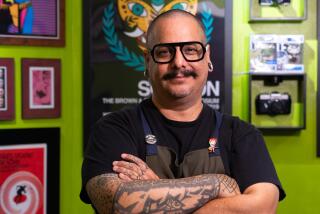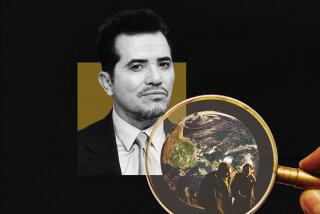Column: Remembering Juan Gómez Quiñones, Chicano studies legend and professor to all of L.A.
The legend of Juan Gómez Quiñones seemed all hype when I sat down for the first day of his History of Chicano People course at UCLA in the winter quarter of 2002.
His large glasses and thick mustache made the professor look more like a kindly retiree than the towering intellectual whom friends had raved about. He ambled around the cavernous Knudsen Hall classroom as students strolled in, struggling to pin a lapel microphone to his collar. In a low, monotone voice, Gómez Quiñones read through the syllabus with all the enthusiasm of a chair.
This was the man famous for his mentorship of generations of Chicano students? Whose output of books, essays and poetry were as prolific as that of Cornel West? Who made enough appearances on Spanish-language radio and television that even my parents knew who he was?
I was a graduate student in Latin American studies at the time, and quickly figured Gómez Quiñones wasnât going to be worth any extra effort. My fellow classmates seemed to feel the same. Some giggled at what was unfolding before us.
But after he finished reading the syllabus, it all clicked.
Gómez Quiñones lectured like an avalanche: a slow and steady rumble of facts that transformed into a cascade of lofty words. We all shut up and listened â and learned throughout the quarter.
The Latinx experience chronicled
Get the Latinx Files newsletter for stories that capture the multitudes within our communities.
You may occasionally receive promotional content from the Los Angeles Times.
He taught us to take pride in what Mexicans and Mexican Americans had accomplished in the Americas. His copious use of film clips â everything from âThe Twilight Zoneâ to âThe Treasure of the Sierra Madreâ to even a âToy Storyâ video game â showed how Americans had long demonized Mexicans.
But rather than whine, our profe urged resistance through engagement with the real world and â just as important â knowledge.
I became a disciple of the man known to his acolytes as âGQ.â One course turned into another, which turned into three, and I asked him to serve as an advisor on my masterâs thesis. He seemed always too harried to help â but all you had to do was ask, and heâd do anything possible to make it happen.
We didnât keep in touch after graduation, mostly because I chose the dark art of journalism over the ivory tower. But I sang the praises of GQ in the decades that followed â and I was proud to hear through the Chicano grapevine that he regularly read my stuff.
GQ ended up teaching at UCLA for nearly 50 years. He was the best type of professor a student could ask for: someone who changes your thinking, who challenges you at all times, but also offers feedback to build you up instead of tear you down.
And he also set an example for ethnic studies that everyone in the discipline should follow: Build a quiet, unassuming legacy not by how many people you can cancel on social media, but by inspiring thousands to fight for civic good instead of personal glory.
Gómez Quiñones died of congestive heart failure Nov. 11 at his home in Pacific Palisades. He was 80.
âThrough the last week of his life, Juan was writing statements and organized a seminar to highlight younger Mexican philosophers,â said his wife, Irene Vasquez. She chairs the Chicana and Chicano Studies Department at the University of New Mexico. âHe was mentoring students until the end.â
âHe was not one to be a grandstander or to say, âYo soy el mero mero [Iâm the best of the best],ââ said UCLA professor Reynaldo MacÃas, a colleague and compadre for nearly 40 years. âHis philosophy was to lead not from behind, but shoulder to shoulder.â
Juan Gómez Quiñones was born in Parral, in the Mexican state of Chihuahua, but migrated along with his family to Boyle Heights as an infant. He graduated from Cantwell High School in Montebello, then went to UCLA to earn his bachelorâs, masterâs and doctorate degrees, working as a Teamster to pay for tuition.
He used his place at UCLA to help stoke the embryonic flames of the Chicano movement into a blaze with direction and passion. Gómez Quiñones counseled the students who went on to lead the mass walkouts at East L.A. high schools in 1968 and collaborated with others to write El Plan de Santa Barbara, one of the foundational documents of Chicano studies and the group formerly known as Movimiento Estudiantil Chicano de Aztlán, or MEChA.
GQ always reminded anyone whoâd listen that Chicanos in academia were a rarefied group in danger of forgetting their roots.
âFor those involved, there is a potential dual alienation from the Chicano community and/or the university and society,â he wrote in a 1974 essay. âYet the need for Chicano technical expertise and the need for more Chicano analysis are prime necessities for the future of the Chicano community.â
âThis is an elitist world, academia, and he always made sure to ground our ethics as servants of our community,â said Jose Luis Serrano Najera, 38, one of Gomez Quiñonesâ last doctoral students. âAnd to always keep that connection. He had this lunch pail mentality that he never lost, and he taught us to always burst through all these closed doors and glass ceilings so that we could pull others behind us.â
That commitment resonated through GQâs career. He helped former students start charter schools, served on the boards of the Mexican American Legal Defense and Educational Fund and the Cal State system, and befriended politicians and UCLA service workers alike. The father of seven also took time to help shape what eventually became the El Pueblo de Los Angeles Historical Monument.
But GQ was never far from students. His ranks of former pupils are legion. High school teachers and college professors. Real-estate agents and artists. Counselors and musicians.
And this contrarian columnist.
Not all of his students were Chicanos, either. Revel Sims is a housing professor at the University of Wisconsin-Madison and laughed when I shared with him my initial take on GQ.
âYouâd have all sorts of people in his classes â football players in the back, Chicano radicals in the front, nerdy folks, and then a sprinkling of white people like me,â said the 43-year-old. âAnd weâre all at first like, âWho is this guy?â But we hung on his every word.â
Sims has autographed copies of most of GQâs books and credits him with teaching a cross-border-activist history of Mexicans in Los Angeles that stretches back to the 19th century. âIt showed me a different L.A.,â he said. âIt just blew my mind then, and I try to channel that thirst for knowing your past and going forward with it all the time.â
Same here. Rest in power, GQ.
More to Read
Sign up for Essential California
The most important California stories and recommendations in your inbox every morning.
You may occasionally receive promotional content from the Los Angeles Times.











